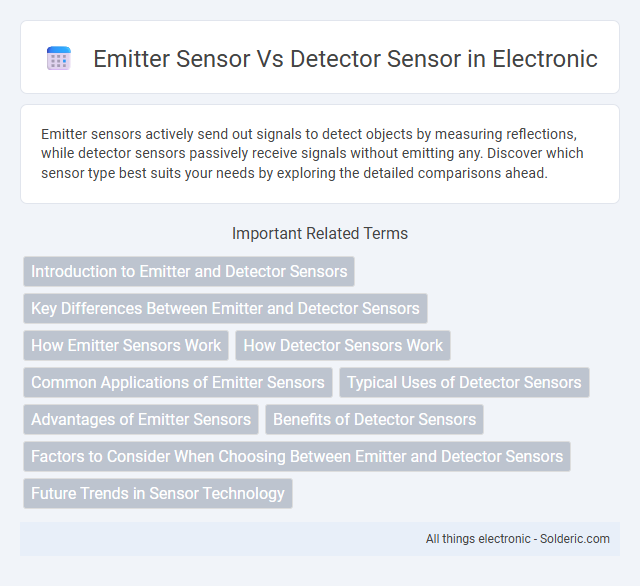Emitter sensors actively send out signals to detect objects by measuring reflections, while detector sensors passively receive signals without emitting any. Discover which sensor type best suits your needs by exploring the detailed comparisons ahead.
Comparison Table
| Feature | Emitter Sensor | Detector Sensor |
|---|---|---|
| Function | Generates signal or energy | Receives and measures signal or energy |
| Role | Source of emission | Signal or energy receiver |
| Common Types | IR LED, Laser diode, Ultrasonic transmitter | Photodiode, Phototransistor, Ultrasonic receiver |
| Application | Signal generation in sensing systems | Signal detection and data acquisition |
| Output | Emits light, sound, or other energy forms | Converts received energy to electrical signal |
| Dependency | Requires power supply to emit | Requires circuit interface for signal processing |
| Examples | Infrared emitter in remote controls | IR sensor photodiode in motion detectors |
Introduction to Emitter and Detector Sensors
Emitter sensors release a specific signal, such as infrared light, to interact with the environment, while detector sensors receive and measure that signal to identify objects or changes. These sensors work together in pairs to enable precise detection and measurement in applications like automation, security, and robotics. Understanding the distinction between emitter and detector sensors helps optimize your system's responsiveness and accuracy.
Key Differences Between Emitter and Detector Sensors
Emitter sensors generate and emit signals such as light or infrared waves to interact with objects, while detector sensors receive and measure these signals after they reflect or pass through materials. The primary difference lies in their roles: emitters are active sources of energy, whereas detectors are passive receivers that convert the incoming signals into usable data. Understanding these distinctions helps you select the appropriate sensor type for precise applications like object detection, distance measurement, or safety systems.
How Emitter Sensors Work
Emitter sensors operate by producing a continuous signal, usually infrared or laser light, which travels to a receiver or detector positioned opposite or near the emitter. When an object interrupts or reflects this emitted beam, the sensor detects the change in signal strength or timing, triggering a response. Your understanding of emitter sensors is enhanced by recognizing their reliance on signal emission and interruption to monitor presence, position, or movement accurately.
How Detector Sensors Work
Detector sensors function by responding directly to physical stimuli such as light, heat, or motion, converting these signals into electrical outputs for analysis or triggering systems. Unlike emitter sensors that generate their own energy signals to interact with the environment, detector sensors passively monitor and measure changes in their surroundings to provide real-time data. Your choice of sensor depends on whether you require active signal generation or passive signal detection for accurate monitoring in your application.
Common Applications of Emitter Sensors
Emitter sensors are widely used in industrial automation for object detection and positioning, particularly in conveyor systems and robotic arms. These sensors excel in applications requiring precise presence or absence detection, such as packaging, assembly lines, and safety light curtains. High-speed sorting and quality control processes leverage emitter sensors for their fast response and reliable operation in harsh environments.
Typical Uses of Detector Sensors
Detector sensors are commonly used in security systems, industrial automation, and environmental monitoring to identify the presence or changes in physical conditions such as motion, temperature, or gas concentration. These sensors play a crucial role in smoke alarms, motion-activated lighting, and chemical leak detection devices, ensuring safety and process efficiency. Your choice of a detector sensor depends on the specific application requirements for accuracy and responsiveness.
Advantages of Emitter Sensors
Emitter sensors offer significant advantages in accuracy and range due to their active emission of signals, enabling precise detection of objects even in challenging environments. They reduce false positives by providing consistent signal intensity and improved sensitivity compared to passive detector sensors. High reliability and faster response times make emitter sensors ideal for automation, safety systems, and industrial applications requiring real-time monitoring.
Benefits of Detector Sensors
Detector sensors offer enhanced accuracy by directly measuring specific environmental changes without requiring an external signal source, reducing interference and false alarms. Their low power consumption and compact design make them ideal for continuous monitoring applications in industrial automation and safety systems. High sensitivity and faster response times improve detection reliability, contributing to better system performance and maintenance efficiency.
Factors to Consider When Choosing Between Emitter and Detector Sensors
Choosing between emitter and detector sensors depends on factors such as detection range, environmental conditions, and target object characteristics. Emitter sensors are ideal for applications requiring precise light or radiation emission control, especially in clear, unobstructed environments, while detector sensors excel in sensing reflected or emitted energy from objects with varied surfaces. Sensitivity, response time, and power consumption are critical parameters influencing the selection of the appropriate sensor type for specific industrial or automation needs.
Future Trends in Sensor Technology
Emitter sensors and detector sensors are evolving with advances in miniaturization, enhanced sensitivity, and integration of AI for real-time data analysis. Emerging trends include the development of smart sensor networks combining emitter-detector pairs for improved environmental monitoring and autonomous systems. Innovations in materials like graphene and advances in optical and infrared sensor technologies promise increased efficiency and wider application in IoT and industrial automation.
Emitter sensor vs detector sensor Infographic

 solderic.com
solderic.com